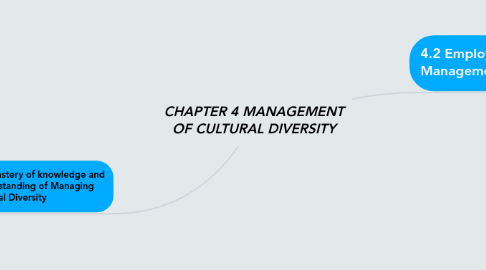
1. 4.1 Mastery of knowledge and Understanding of Managing Cultural Diversity
1.1. 4.1.1 Challenges of Cultural Diversity
1.1.1. Communication Challenges
1.1.1.1. Communication barriers
1.1.1.2. confusion
1.1.1.3. different styles on how they explain
1.1.1.4. unable to verbally express themselves
1.1.2. Discrimination Issues
1.1.2.1. age
1.1.2.1.1. not be able to communicate with different age groups
1.1.2.1.2. resistance to not accept new ideas
1.1.2.1.3. not comfortable with attitude
1.1.2.2. gender
1.1.2.2.1. sexual harrastment
1.1.2.2.2. pay men and women different wages
1.1.2.2.3. different ideas and view
1.1.2.3. Ethnicity
1.1.2.3.1. group identity
1.1.2.3.2. nationality
1.1.2.3.3. minority
1.1.2.4. sexual harrasment
1.1.2.4.1. using sexually suggestive language
1.1.2.4.2. inappropriate touching
1.1.2.4.3. disscusing sexual activities
1.1.3. Training Challenges
1.1.3.1. language barriers
1.1.3.2. personal issues
1.1.3.3. teamwork
1.1.3.4. employees thinks they no need training
1.2. 4.1.2 Employee Relationship Management System
1.2.1. through training
1.2.1.1. optional internship
1.2.1.2. tracking of training actions
1.2.2. Pay
1.2.2.1. prepare statement of payments
1.2.2.2. mailing salary buletins
1.2.3. Recruiting
1.2.3.1. interview new recruits
1.2.4. Competence and career management
1.2.4.1. know how of the emplyees
1.2.4.1.1. implementation of a competence reference
1.2.5. Internal communication
1.2.5.1. permits sesitization
1.2.5.2. breaks the isolation of different sectors of the enterprise
1.2.5.3. transversal information
1.2.5.4. accounting of vacation
1.2.6. Time management
1.2.6.1. works breaks
1.2.6.2. compliance with existing laws
1.2.6.3. payment of overtime
1.3. 4.1.3 The Diversity Management Training Programme
1.3.1. Diversity Training
1.3.1.1. helping employees with different background
1.3.1.2. promoting better teamwork
1.3.1.3. understand and respect each other's differences
1.3.1.4. helping to prevent civil's right violation
1.3.1.5. increasing the inclusion of different identity groups
1.3.1.5.1. opportunity to educate employees
1.3.1.6. main goal to create positive work environment
1.3.2. Importance of Diversity Training
1.3.2.1. to bring out the best in their employees
1.3.2.2. improves the quality of work
1.3.3. Types of Diversity Training
1.3.3.1. Ice breaking
1.3.3.2. Awareness-Based
1.3.3.3. Skill-Based
1.3.3.4. Exploring Language and Definitions Activity
1.3.3.5. Cultural Intelligence Training
1.3.3.6. Cross-Cultural Communication Training
1.3.3.7. Global Business Etiquette
1.4. 4.1.4 Method to Overcome the Stereotypes To Increase Fairness
1.4.1. Beliefs and attitudes
1.4.1.1. respect and value different cultural
1.4.1.2. Increase participants' cultural awareness
1.4.1.3. aware of own values and biases
1.4.1.4. sensitive to own personal biases, racial and other identity
1.4.2. Knowledge
1.4.2.1. understand the power sturcture of society
1.4.2.2. acquire the knowledge about the particular groups
1.4.2.3. aware of the institutional barriers
1.4.2.4. use a wide variety of verbal and non verbal responses
1.4.3. Skills
2. 4.2 Employee Relationship Management System
2.1. 4.2.1 Racial and Ethnic Groups
2.1.1. Race refers to a person's physical characteristic
2.1.1.1. Concept of dividing people into populations or groups
2.1.1.2. example black skin
2.1.2. Ethnicity refers to cultural factors
2.1.2.1. Population groups whose members identify with each other
2.1.2.2. example German
2.2. 4.2.2 Ethnonims
2.2.1. refers to an ethnic groups
2.2.1.1. Ethnocentrism is the belief in the inherent superiority of one's own ethnic group or culture
2.3. 4.2.3 Women as minorities
2.3.1. sexual harassment
2.3.2. sexism and the law
2.3.3. women and politics
2.3.4. sexual differences
2.3.5. social indicators of women status

